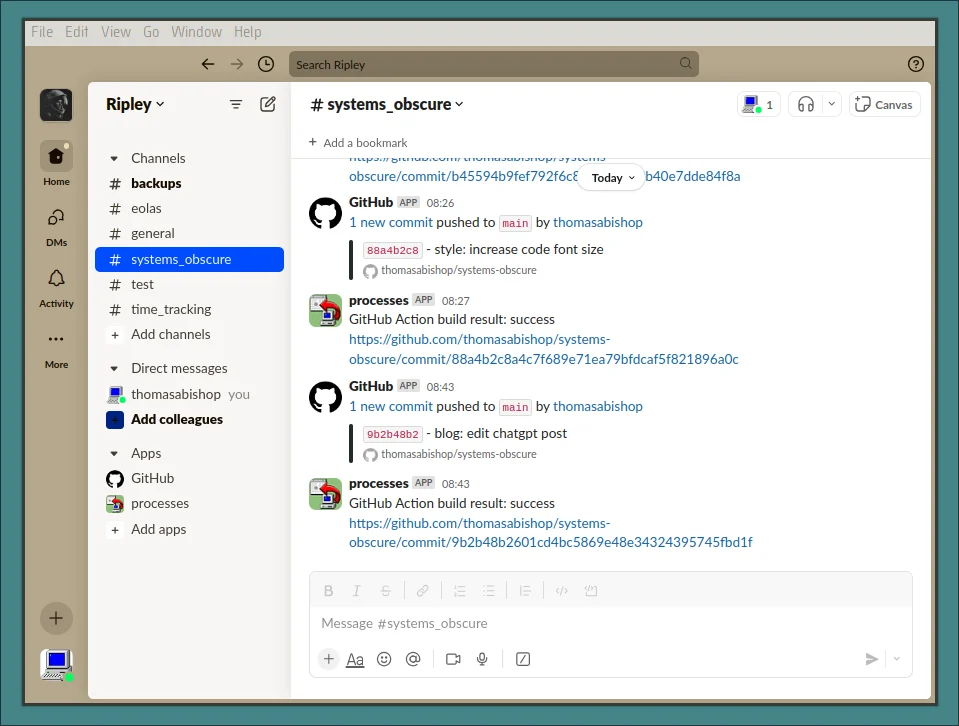4 KiB
| title | slug | date | tags | ||||
|---|---|---|---|---|---|---|---|
| Using Slack as a desktop notification center | /slack-notification-center/ | 2024-04-10 |
|
My current desktop environment is very bare-bones and consists basically of a window manager and launcher. One difficulty of this is having to manage notifications manually.
Triggering notifications is fine, I use swaync. The problem is logging them in one place so I can see at a glance what has been going on over a given time period. There are solutions for the Wayland compositor that I use but the list of notifications won't persist beyond the current session. They are also quite ugly with limited options for style customisation.
When I talk about notifcations, I mainly mean alerts triggered by the automated scripts I have running on my system: backups, auto-commits to my Zettelkasten, time-tracking etc. I don't care about email notifications, Spotify updates etc and suppress these.
I thought a good way to solve this would be to forgo a desktop-specific notification center and instead use Slack. Each notification type has a dedicated channel which I can post to via a specific webhook URL. On the free-plan the data will persist for up to three months which is more than sufficient for my purposes.
This solution has the added benefit that I can access my notification center from other devices. I can also display notifications from more than one machine and everything will be syndicated in one place. Additionally, I can leverage Slack's extensions like the GitHub bot. Finally, using Slack's block architecture means that I have lots of options when it comes to outputting the notification contents.
The image below shows the notification center with the channel for this blog displayed:
(The channel is called "Ripley" because I am an Alien fan! "processes" is the parent app to which the different webhooks belong)
I invoke the NodeJS script below when I want to set up a notification:
#!/usr/bin/env node
const process = require("process")
const { exec } = require("child_process")
const axios = require("axios")
const notificationSound =
"mpv /home/thomas/dotfiles/gruvbox-95/sounds/st-notification.mp3"
const slackNotifier = async (channel, { message = "", block = null } = {}) => {
try {
const webhooks = {
test: process.env.SLACK_WEBHOOK_TEST,
backups: process.env.SLACK_WEBHOOK_BACKUPS,
eolas: process.env.SLACK_WEBHOOK_EOLAS,
systems_obscure: process.env.SLACK_WEBHOOK_SYSTEMS_OBSCURE,
time_tracking: process.env.SLACK_WEBHOOK_TIME_TRACKING,
}
const webhookUrl = webhooks[channel]
let payload
if (message) {
payload = { text: message, channel: channel }
} else if (block) {
payload = { blocks: block, channel: channel }
} else {
throw new Error("Either a message or a block must be provided.")
}
const response = await axios.post(webhookUrl, payload)
if (response.status === 200) {
exec(notificationSound)
console.log(`Message successfully sent to ${channel}`)
} else {
console.error(
`Slack API returned non-200 response: ${response.status}`,
response.data
)
}
} catch (error) {
console.error(`Failed to send message to ${channel}:`, error)
}
}
if (require.main === module) {
const [, , channel, message] = process.argv
slackNotifier(channel, { message }).catch(console.error)
}
module.exports = { slackNotifier }
An example of it being invoked (from within a script that manages my hourly backups):
./slack-notifier/src/index.js 'backups' '💾 Error: backup drive not mounted.'
One drawback is that there is sometimes latency between the execution of the script which contains the notificaton trigger and the appearance of the notification in Slack. This is because the former happens instantly on my machine and the latter depends on the network. I can live with this though.
